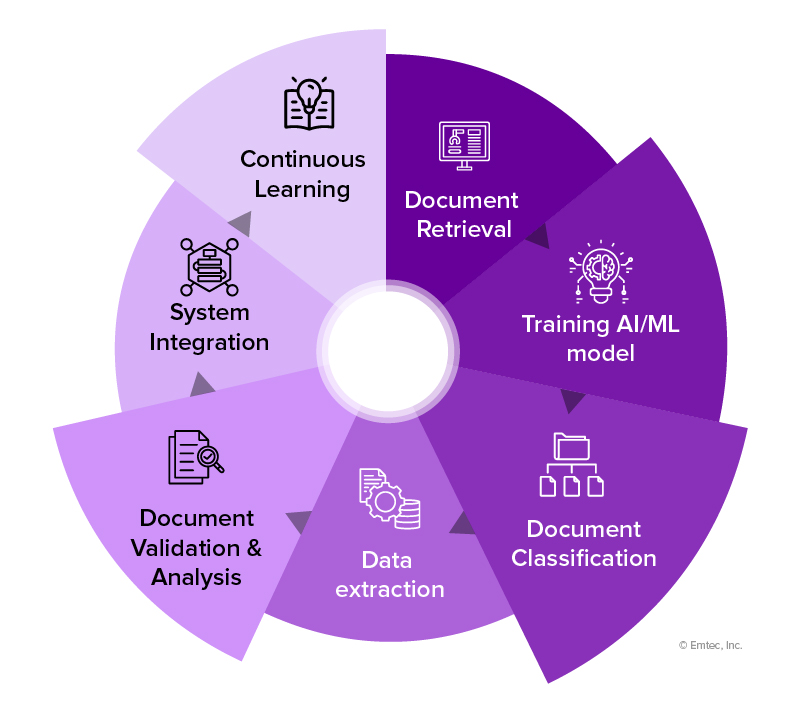In this blog, we delve into the fascinating world of Generative AI and GPT for IDP, exploring its capabilities, benefits, and the transformative impact it brings to Transportation and Logistics.
1. Introduction
Transportation and Logistics (T&L) operations typically generate a substantial amount of documentation, including invoices, purchase orders, bills of lading, insurance documents, delivery notes, proof of delivery documents, export licensing information, customer information, and shipment details etc. Classifying & managing these documents is challenging owing to time-consuming, paper-intensive manual processes that create substantial administrative overheads, more so in case of third-party logistics (3PL). Inefficient document handling causes inconsistencies in the information stored, leading to possibilities of error in logistics operations and financial losses. It may also create shipper-carrier disputes, and lack of proper document management makes dispute resolution a difficult task for T&L stakeholders. Moreover, document processing is a critical step in the load fulfillment process.
Typical loads in Transportation and Logistics deal with four to six documents on an average and validating these documents and storing them for later reference is a highly laborious task.
Considering the volume of documents with these data points flowing across organizations and industries, do you wish there was a sustainable solution to make your document management woes disappear? With Generative AI & LLM s taking centerstage, document processing is rapidly moving towards Intelligent Document Processing (IDP). The method promises an array of sophisticated outcomes in managing vast amounts of documentation while reducing human intervention to a minimum.
According to a survey by the Council of Supply Chain Management Professionals (CSCMP), document management is a top concern for 3PLs, with 59% of respondents citing it as a challenge. – CSCMP State of Logistics Report, 2020
2. How does IDP work?
IDP is a solution that automates the processing of documents using Optical Character Recognition (OCR), artificial intelligence and machine learning techniques. It takes the documents from various formats, such as scanned images, pdf or electronic files, then undergoes pre-processing, and uses OCR to extract text from scanned documents. Using techniques like NLP and machine learning, it can extract user-defined data points or information to process unstructured, semi-structured and structured documents and digitize them for further analysis and storage. NLP also helps to understand the context and semantics of the extracted data, resolving ambiguities and validating the information against the context within the document. Eventually, document classification, analysis, integration with other systems and storage becomes easier and overall document processing and management becomes efficient.
2.1 Here’s an overview of the process:

- Document retrieval/Ingestion (Source/Type of documents) – It involves retrieving relevant documents based on their source i.e., email, cloud or shared storage etc., or document type such as invoice, payment slip, or any type of scanned pdf/images etc.
- Training AI/ML model (data-set testing) – AI/ML model can learn to recognize and extract data sets like amounts, names, dates, addresses, or product information, even from unstructured or semi-structured document.
- Document classification – It typically includes training data to learn how to classify documents accurately based on their type. This training data consists of a set of documents with corresponding labels or categories assigned to them.
- Data extraction – The IDP system extracts specific data points or information from the documents. For example, in an invoice, it may extract details like the vendor’s name, invoice number, date, line items, and total amount.
- Data validation & analysis – IDP systems employ predefined rules to validate the extracted data based on business logic, industry standards, or specific requirements. For e.g., validating the format of a phone number or ensuring that an invoice no. is 10 digits etc.
- System integration – IDP systems often integrate with existing systems/infrastructure to send the data streamline document-centric workflows.
- Continuous training– It involves collecting required data, leveraging feedback loops, incorporating user corrections and manual reviews, to improve the AI/ML model’s accuracy and performance over time, ensuring ongoing adaptation to evolving document processing needs.
3. Understanding Generative AI, GPT & LLMs
Generative AI is a type of artificial intelligence that uses machine learning algorithms to generate completely unique data that doesn’t exist, but it resembles the data it was trained on. The undertaking of AI and ML, as well as the emergence of Large Language Models (LLMs) such as GPT (Generative Pre-trained Transformer), are set to revolutionize the technology landscape across various industries, including transportation and logistics. Generative AI & GPT can help 3PLs automate repetitive tasks, make data-driven decisions, and provide better customer service. LLMs like GPT can be trained on vast amounts of data, enabling them to provide accurate and relevant responses to a wide range of queries. GPT-3, a Generative Pre-trained Transformer, has already made a significant impact on the field of AI and is expected to continue driving innovation and progress in the future. There is a lot of potential for AI, ChatGPT, and its underlying GPT model to bring substantial benefits to the T&L industry.
4. Generative AI and GPT’s impact on IDP:
LLMs have advanced natural language processing capabilities, enabling them to understand the content of unstructured documents. GPT models excel at extracting relevant information by recognizing entities and key data points, allowing accurate and efficient data extraction. Additionally, GPT models aid in document classification, sorting documents based on their content and structure, streamlining document handling processes in IDP systems. Their language modeling prowess allows them to generate text, facilitating error correction and validation in extracted data.
5. How can Generative AI augment IDP with GPT?
Generative AI, especially LLMs like GPT can empower IDP and bring additional capabilities and value to the document processing workflow. Here are some ways we can augment IDP with Generative AI:
- Error correction and data validation
- Document classification
- Natural language generation
- Contextual document analysis
- Document summarization
- Enhanced entity recognition
- Semantic search
- Sentiment analysis
- Language modelling
By combining the power of Generative AI, GPT and IDP, now you can answer questions like the ones below using conversational interfaces:
- Can you provide me with the status of my shipment?
- What are the payment terms?
- Summarize the terms for customs duties and taxes for international shipments
- Where can I find shipping documents?
- Can you translate the document in Spanish?
As per Mckinsey’s report, when it comes to business processes, 60% of occupations could save 30% of their time with automation. There is a huge amount of time and resources that could be saved by automating repetitive tasks.
6. Use Cases
Additionally, these use cases prove how GPT can enhance Intelligent Document Processing in logistics industry:
- Shipping documents management: IDP can automate the processing of various shipment related documents such as shipment records, packing lists, and delivery details etc. GPT extracts of key data, enables efficient document organization and retrieval, and enhances visibility and control on overall shipping operations.
- Contracts and agreements: With GPT’s expertise in data extraction, it can help analyze carrier contracts and agreements to extract relevant terms, rates, and conditions. GPT can generate human-like text, which is beneficial in creating structured agreements, summaries of contract in IDP systems. This can streamline contract management, support accurate billing and settlement processes, and ensure compliance with contractual obligations.
- Bill of lading (BOL) / Proof of delivery (POD) processing: GPT can extract critical data from BOL & POD such as shipment details, carrier information, consignee & recipient details, signature verifications etc. IDP automates validation & processing of these documents which helps in reducing manual efforts, improves tracking accuracy and enhances customer service by offering real time updates.
- Warehouse & Inventory management: IDP can automate the processing of warehouse related documents, inventory reports, receipts etc. GPT extracts relevant data like stock levels, supplier details, updates inventory systems, and facilitates efficient inventory management, stock control, and order fulfillment within warehouse operations.
- Customs clearance: GPT can be used to validate extracted data against predefined rules or patterns. Thus, it helps automate the processing & validation of customs documents, including invoices, customs declarations, and certificates of origin. It extracts necessary data, such as product descriptions, HS codes, and values, to facilitate efficient customs clearance processes, reducing manual effort, and ensuring compliance.
- Carrier and freight management: It automates the extraction of rates, terms, and billing information from carrier contracts, simplifying contract management and ensuring accurate billing. GPT can help identify discrepancies, pricing errors, or missing charges, ensuring accuracy and preventing financial losses.
- Fleet management: IDP can help process and manage various fleet-related documents, such as driver licenses, vehicle registrations, and maintenance records. It facilitates efficient fleet management, ensuring compliance with regulatory requirements, optimizing maintenance schedules, and improving overall fleet performance.
These use cases highlight how GPT can enhance IDP, automate document-intensive processes, reduce manual effort, improve data accuracy, and enhance operational efficiency in the transportation and logistics industry.
7. Bridgenext – Your Digital Technology Partner
While there is a lot of buzz around Generative AI, especially GPT in Transportation & Logistics industry, the need of the hour is the right association with a solution partner. After all, delivering visible results and undeniable profits is important! By partnering with Bridgenext, you can avail our extensive domain knowledge, technical expertise in data handling practices, AI modeling, security measures, and compliance certifications to ensure they meet regulatory requirements. Our team of experts has a deep understanding of document processing challenges for T&Ls including 3PLs. We possess the necessary knowledge and business acumen to address these challenges effectively. Additionally, our goal is always to create a positive impact through our partnership, so we always ensure the solution is high quality and ahead of the curve!
Read of Whitepaper – GPT & Generative AI – Ushering Digital Transformation in Transportation & Logistics to explore how GPT and Generative AI can offer ground-breaking accomplishments in automation for your business.
Reference
www.mckinsey.com/capabilities/mckinsey-digital/our-insights/four-fundamentals-of-workplace-automation



